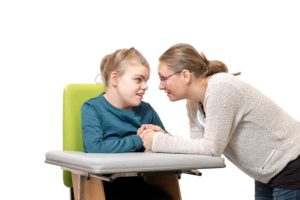Physical Disabilities
Physical disabilities are the result of:
- damage to the brain and the spinal cord, which limits muscular control and movement. Resulting disabilities include seizure disorder and cerebral palsy.
- muscular/skeletal conditions that affect the limbs or muscles, such as juvenile arthritis or a missing limb from an accident or birth.
(Adapted from Smith)
Physical disabilities can be caused by an accident or can be from birth (congenital) or a progressive disease, such as muscular dystrophy.
Other examples of physical disabilities include:
- amputation
- multiple sclerosis
- acquired spinal injury (paraplegia or quadriplegia)
- post-polio syndrome
- cystic fibrosis
- paralysis
- spina bifida
- seizure disorder
What You Might Notice
Children may have one disability or several disabilities. For example, children with cerebral palsy often have both a speech and physical disability. A child’s disability may be visible (spina bifida) or hidden (seizure disorder).
Each child is impacted differently by their disability.
Before Meeting the Child
 If the child uses a wheelchair, plan to meet at a private and safe accessible location.
If the child uses a wheelchair, plan to meet at a private and safe accessible location.
Tell the child’s support person about accessible parking, the entrance, and other accessible features.
Know the accessible transportation options to get to your office, crisis programs, and court. Build in extra time for late arrival from public or private accessible transportation. At times, these delays are inevitable.
Review the child’s Individual Education Plan (IEP).
Talk to teachers, physical and occupational therapists, and family members/caregivers about how the child is impacted by the disability and what accommodations you might need to offer. Examples: The child may become tired at certain times of the day, may need to avoid fluorescent lighting, or may need other physical modifications.
During the Meeting
Ask the child where they would like to sit.
Do not make assumptions about the child’s abilities. Unless another disability is present, children with physical disabilities process information similarly to children without disabilities (Oregon Department of Justice).
If you offer assistance, wait until the child has specifically said how you can help. Do not insist on helping. The child is the expert about what they can or cannot do.
Be respectful of personal space. Do not touch or move wheelchairs, crutches, or other mobility aids without permission.
If the suspect was a caregiver, the child or new caregiver may need help finding a personal care attendant. This service may be available through health insurance, Home Health Services, or other means.
If the child’s wheelchair, walker, or cane is kept as part of evidence, consider how to replace it. These devices support a child’s independence.

